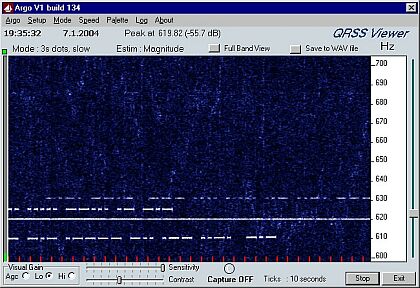Visual CW, alebo pomalá telegrafia, takto nejako by sa dala vysvetliť skratka QRSS. Táto prevádzka sa používa hlavne na VLF pásme 137 kHz. Málokto vie, že QRSS chodí aj na KV, hoci vo veľmi malej aktivite. Trochu som posurfoval po internete a dočítal som sa o niekoľkých frekvenciách, kde sa odporúča s QRSS pracovať – 3585, 7037 a 10140 kHz. Zo stránky www.QSL.net/on7yd som stiahol programy a začal testovať príjem najprv na 137,7 kHz. Na príjem som používal program ARGO od I2PHD/IK2CZL a na vysielanie som pripravil program QRS od ON7YD. Úspech sa dostavil, nejaké spojenia som uvidel na monitore, niektoré stanice som aj počul (zariadenie TS-450SAT a anténa Pyramída na 80 metrov). Následne som začal testovanie na KV.


Výbava na prijímacej strane VK6DI – FT-920, 40m dipól 9m nad zemou. Výkon OM1II (OM100TS) cca 300mW do vertikálu AP8. Na type zariadenia nezáleží, podmienkou je však vysoká stabilita a presné naladenie. Šírka signálu pri takejto rýchlosti, skôr by sa patrilo povedať pomalosti je asi 1 Hz. Program má stupnicu širokú 100 Hz. Ľahko by sa mohlo stať, že sa protistanica môže naladiť mimo danej stupnice. Ide o veľmi slabé signály, ktoré nemusíme počuť, lebo môžu byť pod úrovňou šumu. Prečo ich program však vyhodnotí, to sa treba spýtať matematikov.
Jaro OM1II
